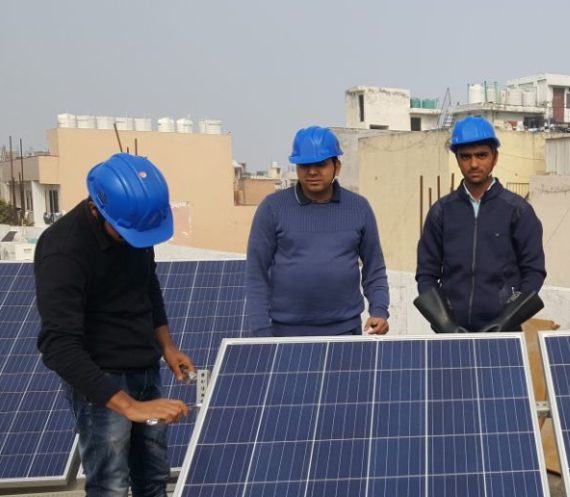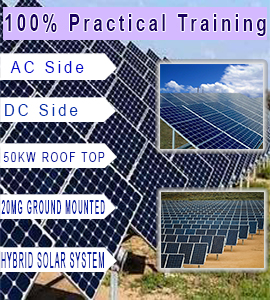Oriented Solar Course In Delhi ( RESEARCH ORIENTED SOLAR COURSES)
Oriented Solar Course In Delhi It covers the Fundamentals of Solar Cells, Technologies of Solar Cells as well as the application of solar cells. This course is divided into three parts.
Part 1 (Chapter 1 through 5) focuses on solar cell Fundamentals.
Part II (Chapter 6 through 8) explains various technologies to fabricate solar cells and PV Modules, and
Part III (Chapter 9 through 12) reviews the use of solar photovoltaic as part of a system for providing electrical energy.

Part 1 Comprises five chapters. The introductory chapter, Chapter 1, sets the background. It gives an idea about the world energy requirements and the role solar PV can play in future energy supply. The introductory chapter also discussed the fossil fuel reserves and their limitation in becoming a sustainable energy source. This chapter also reviews the current status of other renewable technologies.
Chapter 2 explains the fundamental properties of semiconductors such as their crystalline structure, electrons, and their energy levels in the semiconductors.
Chapter 3 is focused on the large carriers and their motion. It mainly covers the drifts and diffusion of charge carriers. The continuity equation is derived, which often serves as starting points in the analysis of semiconductors. A solar cell is a PN junction device: therefore, the principle of formation of a P-N junction is discussed in chapter 4.
The properties of the P-N Junction (e.g. band diagram, the effect of biased, current, and voltage characteristics) and the relevance of these properties from the perspective of a solar cell are dealt with in detail. At the end of chapter 4, solar cell parameters are described. The last chapter of part 1, chapter 5, discussed the design of solar cells. First, the limitation of different solar cell parameters is discussed.

Part II consists of five chapters. The part starts with a discussion on the production of Si in chapter 6.
The Si is the most dominant material used in Solar PV. This chapter is devoted to the purification process of Si, Production of Si ingot, Production of Si wafers, production of Si sheets, and Production of solar-grade Si. Chapter 7 describes the fabrication of solar cells in Si wafers. All the steps used in cell production are covered one by one. The Chapter also reviews the progress that wafer-based solar cell industries have made so far.
In Chapter 8, all the thin-film solar cell technologies are discussed. This includes the amorphous Si Cells. CdTe cells, CIGS cells, and thin-film crystalline Si Cells. The chapter starts with a discussion on common features of thin-film technologies, and thin-film technologies are described individually in terms of material properties, device structure, and fabrication.
Part III is divided into four chapters. Chapter 9 gives the procedures for the estimation of solar radiation at the given location and time. The knowledge of the solar radiation is helpful in optimization of PV system Size.
In chapter 10, the Fabrication of Solar PV modules, based on Si wafers, is described. It also presents the parameters of the module and their variation as a function of temperature and radiation. The battery, Inverter, and Charge controller form the Balance of the System (Bos). These components, with their design and properties, are introduced in chapter 11. Finally, the configuration of various PV systems and the design are reviewed in Chapter 12. It also deals with the design of PV Systems for DC loads, Lighting load, and grid-connected Systems.
Oriented Solar Course In Delhi
Research Oriented Solar Course Syllabus:
1. Necessity and Place of PV Module and Energy Scenario in World.
2. Detailed Concepts of Solar Materials (Semiconductors).
3. Brief Study on Charges Carriers in Semiconductors
4. P-N Junction Diode: Overview and Introduction of Solar Cell
5. Parameters Should Keep in Mind while designing of Solar Cell
6. How could you convert Raw Silicon into a Wafer of a solar cell?
7. Si wafer Based Solar Cell Technology or Crystalline Solar Cell
8. Thin Film Solar Cell Technology
9. Detailed Study on Fuel of Solar System or Solar Radiation. Solar PV Module
10. Detailed about Balance of Solar PV Systems
11. Designing Procedure of Solar Power System.
If you wanna know about Oriented Solar so visit here.
Course Features
- Real-life Practice Studies
- Real-life Case Studies
- Assignments
- Lifetime Access
- Expert Support
- Global Certification
- Job Portal Access
Register yourself to grow your knowledge
© 2020 DigiManthan Technical Training Institute - All Rights Reserved.




Joining Digi Manthan was best decision I made this year. I was doing nothing productive and then I had to push myself to do some work. So, I joined solar energy course in Digi Manthan and I was so satisfied. I started doing something productive in my life and my trainer supported me till the last. I am so grateful to join Digi Manthan.
Ashutosh Sharma